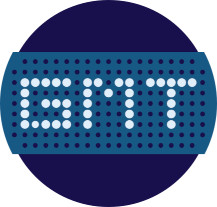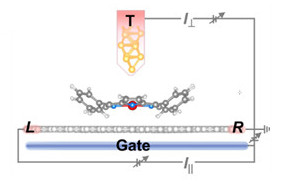
Knowing how to manipulate at the nanometric scale, a single spin, as an object carrying quantum information, presents a major technological challenge, and still remains a subject of great fundamental interest. A magnetic molecule deposited on a surface offers a unique test system to treat this subject, but it is difficult, if not impossible, to explore experimentally the too numerous open possibilities, given the huge number of possible molecule/surface combinations. This is why modeling plays an essential role in this field.
In the frame of the H2020 FET-Open project “COSMICS”, a collaboration between the Technical University of Denmark (DTU), the CEMES CNRS in Toulouse and SPEC (UMR CEA-CNRS) has shown by computational methods of electronic structure and transport that iron porphyrin, deposited on a boron-doped graphene substrate, possesses remarkable properties that makes it a potential candidate for a molecular spintronic device driven solely by the application of a gate voltage. This device would therefore be worth studying experimentally.

The tetraphenyl iron porphyrin (FeTPP) molecule is very special and plays a key role in the oxygen transport of haemoglobin. Its exceptional properties are intimately linked to the magnetic state of the central iron atom and its sensitivity to the environment (in particular the hybridization of the iron atom). For example, we recently showed in collaboration with an experimental team (scanning tunneling microscopy study) that, depending on the substrate (gold or graphene) on which the molecule is deposited, it can adopt different electronic fillings [1]. Furthermore, recent work has shown that a slightly similar molecule changes its spin state when deposited on a graphene substrate doped with nitrogen[2]..

We therefore undertook to model, by density functional theory (DFT) approaches, an FeTPP molecule deposited on a nitrogen or boron doped graphene substrate (Figure 1a). In the case of nitrogen, we observe only a slight shift of the levels of the molecule, while when the molecule is above a boron atom; a drastic change takes place due to the hybridization between the dz orbital of iron and the pz orbital of boron. Thus the molecule goes from a spin S=1 to S=3/2 and the iron goes from an oxidation state Fe2+ to Fe3+, moreover one observes an important magnetic polarization of the underlying boron atom. An even more interesting result is obtained when a negative gate voltage is applied under the graphene plane. Indeed, in this case the molecule reverts to its S=1 state (Figure 1b) as on undoped graphene where the interaction is much weaker and the magnetic polarization disappears on the boron.
These results highlight a mechanism for “writing” a spin at the atomic scale. We can go one-step further by calculating the two-dimensional electronic transport in the graphene plane. Indeed, we have demonstrated a significant spin polarization (>10% for a realistic coverage rate of the graphene by FeTPP) of the electronic transport at the Fermi level in the absence of gate voltage (Figure 1c). Such spin polarizations are perfectly detectable by experimental methods such as shot noise measurements. These complementary results show that it is therefore not only possible to write but also to read the spin. Furthermore, it is also possible to probe the state of the molecule via an STM tip.
We have therefore proposed a new concept for writing and reading spin states at the single molecule scale using a process that requires an electrical operation (gate voltage) that is much less energy consuming than the application of a magnetic field or of an intense electric current. This work, published in Physical Review Letters [3], could pave the way for the development of new low-power spintronic devices.
References:
[1] “Intraconfigurational transition due to surface-induced symmetry breaking in noncovalently bonded molecules”,
Mehdi Bouatou, Rishav Harsh, Frédéric Joucken, Cyril Chacon, Vincent Repain, Amandine Bellec, Yann Girard, Sylvie Rousset, Robert Sporken, Fei Gao, Mads Brandbyge, Yannick J. Dappe, Cyrille Barreteau, Alexander Smogunov, and Jérôme Lagoute, J. Phys. Chem. Lett. 11 (2020) 9329.
[2] “Non-covalent control of spin-state in metal-organic complex by positioning on N-doped graphene”,
Bruno de la Torre, Martin Švec, Prokop Hapala, Jesus Redondo, Ondřej Krejčí, Rabindranath Lo, Debashree Manna, Amrit Sarmah, Dana Nachtigallová, Jiří Tuček, Piotr Błoński, Michal Otyepka , Radek Zbořil, Pavel Hobza & Pavel Jelínek, Nature Communications 9, 2831 (2018).
[3] “Proposal for all-electrical spin manipulation and detection for a single molecule on boron-substituted graphene”,
Fei Gao, Dongzhe Li, Cyrille Barreteau, Mads Brandbyge. Phys. Rev. Lett. 129, 027201 (2022). Editor’s suggestion.
This work has been done in the context of the COSMICS project, which has received funding from the European Union's Horizon 2020 research and innovation programme under Grant agreement No. [766726].
Contact CEA-IRAMIS : Cyrille Barreteau (SPEC/GMT).
The H2020 FET-Open project “COSMICS”. WEB site of the project.
Collaboration :
- Dongzhe Li, Laboratoire CEMES CNRS , MEM, 29, rue Jeanne Marvig, BP 94347, 31055 Toulouse Cedex 4 , France
- Mads Brandbyge & Fei Gao, DTU Physics, Department of Physics, Technical University of Denmark, Fysikvej, building 311, 2800 Kgs. Lyngby





